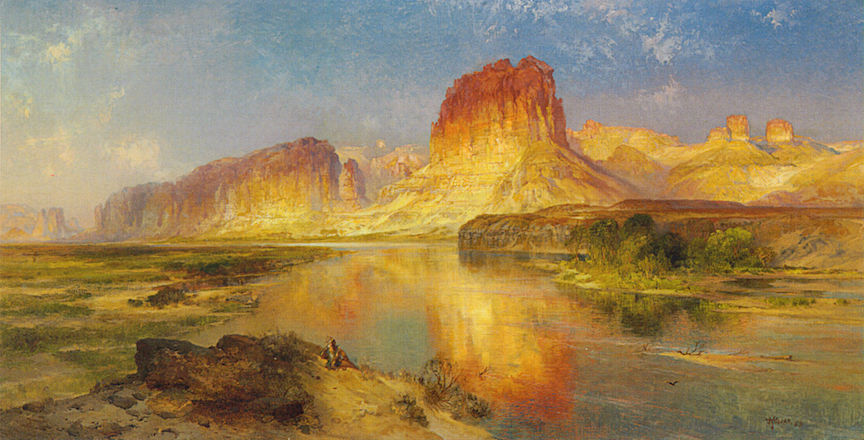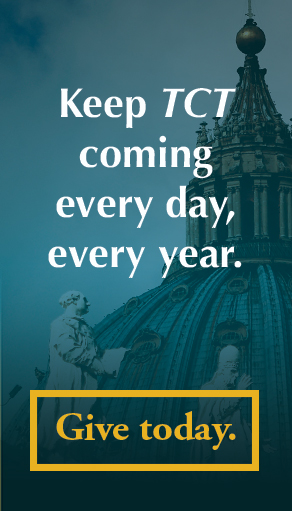I was recently driving by suburbs in Denver and noticed a block of new condominiums equipped with solar panels on the roofs. “How sustainable,” I thought to myself. In my defense, I was breathing the liberal air of Colorado. Its spirit was, no doubt, inspiring thoughts my mind would ordinarily never conceive of in healthier climes.
But it was only a passing whiff of insanity, and only lasted a moment. The next thought that came to mind was, “Who will care in thirty years if they are electrically self-sustaining? With such a lack of basic beauty, will souls formed in such suburbs be worth the massive effort of converting to sustainable resources?” When will we begin treating Beauty as a valuable resource that needs to be not just sustained, but consistently cultivated? Without it, human life as we know it is not sustainable – or even desirable.
My road trip continued, and I sped on, over the Colorado border into Wyoming. The landscape quickly became more mountainous. The sun was low in the sky, the air thick with the golden haze of smoke blown down from Canadian forest fires. Ridge upon ridge of hills and mountains surrounded the straight and nearly deserted roads.
Rays of light broke through the gilt-edged clouds. The soft yellow-pink of evening light clothed the stark landscape with an intimate and sensual warmth. Puddles of snowmelt among the sagebrush glinted and flashed as I ate through the miles of solitude. Occasionally I passed an antelope or deer meandering along the side of the road.
I turned the music up on my stereo, strangely juxtaposing the wild landscape with the soundscape of sixteenth-century Venice. I was listening to this recording of In ecclesiis by Giovanni Gabrieli. What struck me as the golden light and gray evening shadows flickered over my windshield was how harmonious with itself beauty is. The wild beauty of Wyoming was not only consonant with but even complementary to the complex and refined polyphony of one of Europe’s cultural monuments.
What does a man need? Solar panels and plastic-looking rows of identical apartments? Sustainable electricity to power humanity’s pocket palantirs (AKA “smart” phones)?
Or mountains with golden sunsets, and Venetian music with brass ensembles? On the one hand, we have artificiality, made by man and for man; on the other, creation and sub-creation made by God and for God, but for this reason uplifting and bringing a sense of completion to man as man.
A psalm verse comes to mind: Domine, dilexi decorem domus tuæ, et locum habitationis gloriæ tuæ. “I have loved, O Lord, the beauty of thy house; and the place where thy glory dwelleth.” (Psalm. 25:8) A place where God’s glory dwells is His “first book”– His immense and beautiful creation. One additional “beauty of God’s house” is the beauty that Christianity has inspired in the arts for 2,000 years.

What do the beauty of God’s house and the place of His glory elicit in us? Love and delight – dilectio. “I have loved, O Lord. . .” When was the last time the beauty of solar-powered suburbs moved your heart to either love or delight?
Love and beauty are necessary for man, formed in the image and likeness of God’s Beauty and Love. Fyodor Dostoevsky famously made the bold claim that. “Beauty will save the world.” He also said that mankind can live without science, bread, and many other things: it “cannot live without beauty.”
Scientists like Carl Sagan demean humanity with their atheistic “stardust” quips, as if the truth in such a statement as “we are all made of star stuff” both raises our spirits and does away with the unique significance of man in the universe. Philosophers like Jean-Paul Sartre, in statements such as “hell is other people,” reject the light of life and choose the depths of the abyss instead. Artists like Pablo Picasso, evidently capable of truly delicate and fine art as we see from his early paintings, choose to revel in disjointed depravity instead. These reactions all stem from a refusal of reality.
The poet Richard Wilbur (1921-2017), recognized that man had a different end. In his poem “Mayflies,” he speaks of how, in a moment of existential melancholy, he realized that he
had been called to be
Not fly or star
But one whose task is joyfully to see
How fair the fiats of the caller are.
Where Sagan sees man as nothing more than stardust, and Sartre and Picasso their fellow men as buzzing flies or mating animals, Wilbur – along with the common sense of even pre-Christian humanity – recognizes the way in which man is called to a contemplation of transcendent beauty, which can only be divine in origin. The non-believers belong to the world built on the foundations of solar-powered suburbs.
In the final analysis, Wilbur belongs to the world of the psalmodizing King David, of Catholic Venice, and the Wild West. Which of these worlds do we want to inhabit and empower?
Beauty and love must exist if this transformative encounter is to happen; both are endangered species in the suburbs and cities of the world now, and not just in Denver. The shakers and movers of this world do not recognize this truth; but pockets of beauty-lovers still flourish, fighting for and preserving the beauties of field and faith of which Psalm 25 seems to speak.
From monks in the fields of Oklahoma to musicians singing music like Gabrieli’s in its proper setting, to Wyoming Catholic College whose motto is “Truth, Goodness, and Beauty,” the quest for “sustainable energy” continues. The truly sustainable energy of the transcendentals, the true power sources that must be sustained above all others if the fullness of humanity is to survive.

















